Annals of the MBC - vol. 5 - n' 3 -
September 1992
EPILEPSY AND BURNS
Napoli B., D'Arpa N., Masellis M.
Divisione di Chirurgia Plastica e Terapia delle Ustioni,
Ospedale Civico USL 58, Palermo, Italy
SUMMARY. A description is given of
cases of burns occurring during epileptic seizures in the period 1975-1991. Such cases
usually require considerable commitment at the level both of surgical treatment and of
rehabilitation.
Introduction
A review of the clinical files of the patients admitted to our Centre between 1975 and
1991 revealed 14 cases of persons whose burns occurred because of and during an epileptic
seizure.
The relationship between epileptic seizures and traumas is fairly obvious, since the
attack begins with a fall and loss of consciousness, followed by convulsions. There is
however an equally clear connection between epilepsy and burns, if the phenomena that
trigger the onset of the epileptic seizure occur in the vicinity of burn agents.
It must also be remembered that epilepsy strikes persons in otherwise good health, and
generally without any warning signs, so that there is no defence against falling.
In the 14 cases selected we considered some epidemiological aspects (age, sex, place of
accident, burn agent) and the clinical aspects (site, depth and course of burn) in order
to describe the characteristics of burns due to epilepsy.
Case histories
Case 1. B.B., female, age 73 y., suffered burns on 17-4-77 by falling over hot
stove. Admitted with full-thickness burns covering 10% BSA, involving abdomen, front of
thighs, forearm and hand. Subjected to free skin graft on 3-5-77 and discharged as
out-patient on 26-5-77.
Case 2. C.A., female, age 55 y., spilt pot of boiling water over herself. Admitted
to another hospital, then sent on to our Burns Centre on 2-2-80 presenting superficial and
full-thickness burns in 75% BSA, involving abdomen, inguinal region, inside thighs
including vulvar region. Free skin graft applied on 19-2-80. Discharged as out-patient on
5-3-80.
Case 3.P.S., male, age 33 y., admitted on 18-12-80 with full-thickness burns on
back of right hand caused by contact with hot stove. On 3-1-81 the patient was subjected
to cleansing of the necrotic tissues, including the extension tendons of the 2nd and 3rd
fingers which were affected by necrosis, and then to coverage with free skin graft. After
4 weeks (31-1-81) the articular capsules of the proximal interphalangeal joints of the
second and third fingers were reconstructed with skin graft, the long fingers subjected to
surgical syndactyly, and the back of the hand covered by means of an abdominal
arterialized flap. Disharged as out-patient the day after separation from abdominal pocket
(26-2-81). The patient was followed up until May 1984. During this period he was
frequently readmitted and operated on, continuing functional training between hospital
stays.
In particular, the patient was readmitted:
- from 10-11-81 to 9-12-81 for separation
of surgical syndactly of 2nd and 3rd fingers and modelling of 2nd finger (29-11-81);
- from 22-4-83 to 15-5-83 for separation of surgical syndactyly of 3rd and 4th fingers
(30-4-83);
- from 7-5-84 to 21-5-84 for separation of surgical syndactyly of 4th and 5th fingers and
modelling (15-4-84) (Figs. I a, b, c, d, e).
Case 4. G.S., male, age 52 y.,
admitted on 5-3-82 with full-thickness circumferential burns in right leg and thigh and on
back of left leg and thigh covering about 15% BSA. The patient, a blacksmith, had been
working and during an epileptic seizure he had fallen on to a redhot piece of iron which
set fire to his trousers. Subjected to 2 free skin graft operations (25-3-82 and 11-5-82)
and discharged as out-patient on 22-5-82.
Case 5. F.A., female, age 43 y., spilt pot of boiling water over herself on
23-12-85, suffering superficial burns in 20% BSA involving right anterior face of thorax,
the posterior region, left forearm, left buttock. The patient received medical treatment
only and was discharged as out-patient on 18-1-86.
Case 6. T.G., female, age 55 y., burned on 18-3-87 by falling over a brazier.
Admitted first to another hospital, and transferred to our Centre about 24 hours later
with extensive full-thickness burns covering 30% BSA (circumferential burns in right upper
limb, and bums in volar face of left forearm, back of thorax and of neck, front and right
thorax, face and head). Pressure-relieving incisions necessary in right upper limbs. An
operation was performed on 14-4-87 during which only partial coverage of bloody areas was
effected. Patient died on 6-5-87, 3 weeks after operation, because of septic shock.
Case 7. C.M., female, age 47 y., on 18-10-87 spilt pot full of tomato sauce,
suffering superficial and full-thickness burns covering 18% BSA, involving thorax,
abdomen, inguinal region, medial face of both thighs, front of right leg, left forearm and
arm, right forearm and hand. Free skin graft a`pplied on 17-11-87. Discharged as
out-patient on 20-11-87.
Case 8. P.A., male, age 76 y., on 2-4-88 spilt boiling water over himself,
suffering superficial and fullthickness burns in thorax and at root of both thighs (7%
BSA). Free skin graft applied on 19-4-88. Discharged as out-patient on 4-5-88.
Case 9. D.P.M., male, age 66 y., touched hot stove, suffering superficial burns in
thenar of left hand and back of 2nd and 3rd fingers of right hand. Admitted on 20-1-89,
several days after accident, with infected burns. Treated and cured with medical and
topical therapy, discharged on 24-2-89.
Case 10. D.M.G., female, age 22 y., on 20-7-89 suffered superficial and
full-thickness bums (18% BSA) due to hot oil. Discharged herself after 3 days but returned
to be readmitted on 31-7-89 presenting infected third-degree burns in breasts, abdomen and
thighs. Free skin graft applied 7-8-89. Discharged as out-patient on 21-8-89. .
Case 11. T.F., female, age 25 y., suffered superficial and full-thickness burns
caused by boiling water affecting left arm and forearm. Admitted on 1-11-90, free skin
graft applied on 13-11-90, discharged on 10-12-90.
Case 12. P.M., female, age 38 y., on 24-6-91 spilt pot of boiling water over
herself, suffering superficial and full-thickness burns in 10% BSA, affectiN abdomen,,
front of thighs and legs, anterior face of right forearm. Free skin graft applied on
19-7-91. Discharged as out-patient on 26-7-91.
Case 13. G.L., female, age 33 y., on 22-10-91, while ironing, came ;nto contact
with iron and suffered a clearly defined full-thickness burn in the right lateral region
of neck, right cheek, right auricle and right mastoid region. Free skin graft applied on
25-10-91 and 12-12-91. Discharged on 16-12-91 as out-patient. Has used silicone gel sheets
applied on residual scar tissue and still wears elastic pressure garment (Figs. 2 a, b, c,
d).
Case 14. L.S.P., female, age 20 y. Admitted on 8-3-92 some days after burn
accident, suffering from superficial and full-thickness burns in the parotid region and
right auricle caused by fall on to hot stove. Free skin graft applied on 13-3-92,
discharged on 25-3-92. Continues to attend out-patients clinic and wears elastic pressure
garment.
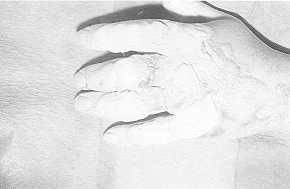 |
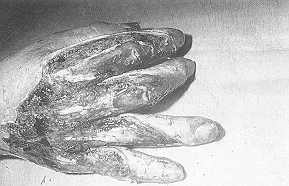 |
| Fig. 1a |
Fig. 1b |
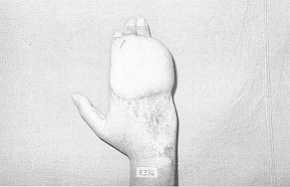 |
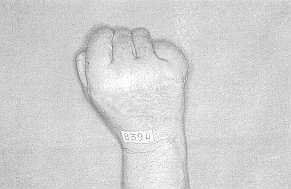 |
| Fig. 1c |
Fig. 1d |
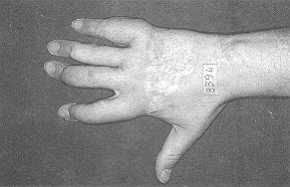 |
Fig. 1e |
|
Considerations
Age and sex
Of the 14 patients who suffered burns during an epileptic seizure, 10 were women, with a
female to male ratio of 2.5 to 1. The average age of the women was 41.1 y., (min. 20, max.
73; S.D. 16) and of the men 56.7 y. (min. 33, max. 76; S.D. 16.1). These findings confirm
other data in the literature indicating that epilepsy, together with other chronic
neuropsychiatric diseases, alcoholism and drug addiction, ranks as one of the most
important factors in burn risk among the adult population.
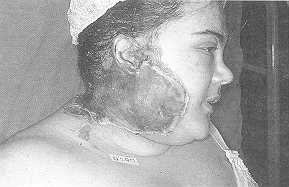 |
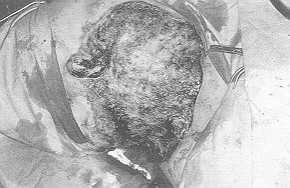 |
| Fig. 2a Contact
burn by hot iron. Appearance on admission. |
Fig. 2b
After surgical escharectomy. |
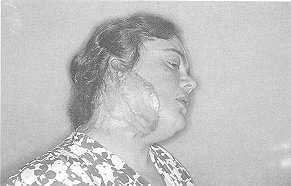 |
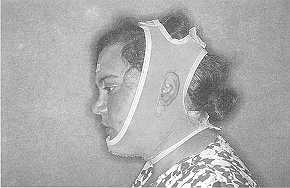 |
| Fig. 2c
Appearance after 5 months. |
Fig. 2d
Patient continuing rehabilitatory treatment. |
|
Activity
Regarding the professional activity of the patients, the fact that the 10 women were all
housewives and two of the men were pensioners aged over 65 y. explains the prevalence of
bums in the home (Tab. 1); it also has to be considered that epilepsy is a contributory
factor obliging the person to remain at home. With regard to the remaining 2 cases (males
of working age), in only one of these were the bums caused by an accident at work. In this
particular case (Case 4) the burn agent was fire. This case presents a triple risk: that
of the illness itself, that of the blacksmith's trade with its use of potentially
dangerous materials and tools, and that deriving from the fact that these materials and
tools, with the sensorial stimulations that they emit, are possible triggering factors in
an epileptic seizure.
Certain domestic activities, such as ironing (Case 13), are however equally risky for
epileptic subjects.
Regarding the other lesive agents and mechanisms, in 5 cases the burn was caused by a fall
on to open sources of heat; the remaining cases were caused by hot liquids. The ratio
between non-liquid and liquid burns agents is thus I to I in our study.
Site of lesion
Regarding the part of the body affected by the burn the prevalence of bums caused by
liquids and fire over contact burns accounts for the greater number of burns in multiple
body sites. However, epileptic subjects characteristically suffer burns in critical areas,
particularly on the back of the hands or one side of the face (Tab. 2). This is because
during an epileptic seizure the patient falls in a state of unconsciousness with the
muscles of the body stiff, so that the head turns to one side or stretches back
(episthotonus), the upper limbs being projected forward and the fingers clenched.
Case accident |
Place of |
Burn agent |
I |
Home |
Contact |
2 |
Home |
Liquid |
3 |
Home |
Contact |
4 |
Work |
Fire |
5 |
Home |
Liquid |
6 |
Home |
Fire |
7 |
Home |
Liquid |
8 |
Home |
Liquid |
9 |
Home |
Contact |
10 |
Home |
Liquid |
I I |
Home |
Liquid |
12 |
Home |
Liquid |
13 |
Home |
Contact |
14 |
Home |
Contact |
|
Table 1 Distribution
according to place of accident and burn agent |
|
Therapy
Other data concern the type of treatment administered, the duration of
hospitalization, and the outcome.
Regarding treatment, healing was achieved by exclusively medical treatment in only 2 cases
out of 14. The average number of operations per patient was 1.3 (min. 0, max. 6; S.D.
1.3). The average duration of hospitalization per patient was 47.7 days (min. 17, max.
166; S.D. 36.1).
Only one patient died: in this case the depth of the burn was associated with considerable
extent in about 30% BSA (Case 6).
Conclusions
We found that'
- the burn agent, if fire or some incandescent
material, can trigger the epileptic seizure because of the light stimuli that they emit;
- epilepsy is an important predisposing factor in bums;
- epilepsy, given the characteristics of the seizure, can also condition the site of the
bum which in typical cases is localized in important critical areas (face, hands).
Epilepsy may also lead to the bums being
deeper owing to the longer exposure to the bum agent as a result of the patient's loss of
consciousness during the seizure. The deeper burns in critical areas require greater
commitment both at the level of surgical treatment and from the point of view of
functional and aesthetic rehabilitation.
This leads to longer hospitalization, often with multiple hospital stays, a higher number
of surgical operations which are often more complex than simple free skin grafts, and
protracted out-patient treatment.
The 14 cases which over a long period of time we have observed certainly constitute only a
small number; however, behind small numbers there are frequently more serious cases that
require greater commitment.
| Case |
Site of burn |
Treatment |
Number of operations |
Days of hospitalization |
Outcome |
| I |
Plurima |
Med. and surg. |
1 |
39 |
Discharge |
| 2 |
Plurima |
Med. and surg. |
1 |
31 |
Discharge |
| 3 |
Back of |
Med. and surg. |
6 |
166 |
Discharge |
| |
right hand |
|
|
|
|
| 4 |
Plurima |
Med. and surg. |
2 |
78 |
Discharge |
| 5 |
Plurima |
Med. |
- |
26 |
Discharge |
| 6 |
Plurima |
Med. and surg. |
1 |
55 |
Death |
| 7 |
Plurima |
Med. and surg. |
1 |
33 |
Discharge |
| 8 |
Plurima |
Med. and surg. |
- |
|
Discharge |
| 9 |
Palm of left |
Med. |
- |
35 |
Discharge |
| |
hand; back of |
|
|
|
|
| |
right hand |
|
|
|
|
| 10 |
Plurima |
Med. and surg. |
1 |
25 |
Discharge |
| I I |
Left upper limb |
Med. and surg. |
1 |
39 |
Discharge |
| 12 |
Plurima |
Med. and surg. |
1 |
32 |
Discharge |
| 13 |
Right side |
Med. and surg. |
2 |
55 |
Discharge |
| |
of face |
|
|
|
|
| 14 |
Right side of face |
Med. and surg. |
1 |
17 |
Discharge |
|
Table 2 Distribution
according to site and course of burn |
|
RESUME En analysant les cas qu'ils ont
observés pendant la période 1975-1991, les auteurs décrivent les charactéristiques des
brdlures subies pendant une crise du grand mal qui dans les cas plus typiques exigent un
grand engagement au niveau soit du traitement chirurgical soit de ]a réadaptation.
BIBLIOGRAPHY
- Bergamini L.: "Manuale di Neurologia clinica---.
Libreria scientifica Cortina, Torino, 1975.
- Cagnoni G., Lauro R., Masellis M.: Epilessia e Ustioni.
Archivio degli Istituti Ospedalieri S. Corona, 30, 6: 609-621, 1965.
- Caroli A., Monteleone M., Bertani A., Mingione A. Cristiani
G.: Lesioni complesse della mano. Ustioni termiche ed clettriche. Riv. Chin Mano, 16, 2:
161-167, 1979.
- Feldman J.J.: Facial Bums. In "Plastic Surgery",
ed. McCarthy, vol. 3, chap. 41, Saunders, Philadelphia, 1990.
- Kazanjian -Converse: "ll trattamento chirurgico dei
traumi facciali", vol. 2, chap. 29, Picein, Padova, 1988.
|








